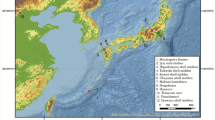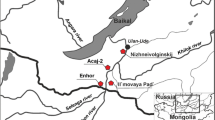Abstract.
The Kabukai A site (5 to 8C A.D.) of the Okhotsk cultural area is on Rebun Island, a small island near the coast, north–northwest of Hokkaido, Japan. Specimens of Sus scrofa, called the Sakhalin pig, were discovered in five cultural layers at the Kabukai A site. Ancient DNA was extracted from the remains of 42 Sakhalin pig bones. Thirty-nine nucleotide sequences of the 574-bp mitochondrial DNA control region, estimated to have originated from at least 21 individuals, were amplified and analyzed phylogenetically. Nine distinct haplotypes (A1, A2, A3, B1, B2, C1, C2, D1, and D2) from this site were classified into four haplotype groups (A, B, C, and D) by parsimonious network analysis. Phylogenetic analysis of 9 ancient and 55 modern haplotypes indicated that the population of Sakhalin pigs at the Kabukai A site belonged to two distinct clusters; haplotype groups A and B formed a cluster comprised only of themselves, and haplotype groups C and D belonged to the cluster of one of the two genetic groups of Japanese wild boars uniquely distributed in the western part of Japan, including one northeast Mongolian wild boar. Analysis of the haplotype distribution among three archaeological sites and their historical transitions among the five layers reflecting the cultural periods at the Kabukai A site suggests that the Sakhalin pig populations were introduced from Sakhalin island and the Amur River basin in the northeastern Eurasian continent together with some cultural influences.
Similar content being viewed by others
Author information
Authors and Affiliations
Additional information
Received: 18 April 2000 / Accepted: 24 November 2000
Rights and permissions
About this article
Cite this article
Watanobe, T., Ishiguro, N., Okumura, N. et al. Ancient Mitochondrial DNA Reveals the Origin of Sus scrofa from Rebun Island, Japan. J Mol Evol 52, 281–289 (2001). https://doi.org/10.1007/s002390010156
Issue Date:
DOI: https://doi.org/10.1007/s002390010156




